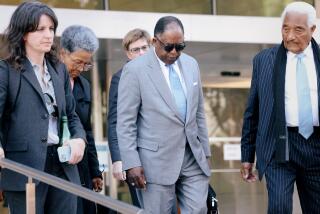Early Ruling Rendered Raabe All but Defenseless
- Share via
SANTA ANA — Former Assistant Treasurer Matthew R. Raabe did not deny that he participated in the scheme to skim nearly $90 million from the accounts of cities, school districts and other government agencies.
He simply contended that his actions were not crimes. In the end, the jury rejected his argument.
Legal experts said Raabe’s fate was virtually sealed when Superior Court Judge Everett W. Dickey ruled that Raabe had been obligated by law to distribute all of the interest the county-run pool was earning--not just a portion, as Raabe contended.
From the outset of trial, the evidence presented against Raabe by Senior Deputy Dist. Atty. Matthew Anderson was overwhelming:
* There was the damaging testimony from former co-workers--who described themselves as chums of Raabe--that he showed them how to perform accounting procedures that diverted some interest earnings from the investment pool to the county treasury.
* There was the pointed accusation by the defendant’s ex-boss, former County Treasurer-Tax Collector Robert L. Citron, that Raabe proposed the diversion scheme to avoid paying high yields to pool investors. Raabe feared that pool investors would stage a so-called run on the bank because they would associate high yields with casino-type bets Citron was making in the $7-billion investment pool.
* There were the tape recordings of Raabe defending Citron’s investment strategy before investors, even as the investment pool tottered toward collapse. In a few tape-recorded meetings, Raabe explained how the treasurer’s office apportioned interest by calculating yields on “every security” in the pool, then determining each agency’s average balance in the portfolio before distributing the payments. The prosecution played the recordings to undercut Raabe’s suggestion that the county was under no obligation to distribute all of the interest earned by the pool.
* And there were Raabe’s own handwritten notes to Citron: “Extra interest we moved from the commingled pool.”
*
With mountains of documents and evidence against their client, Raabe’s attorneys contended the county was entitled to a disproportionate share of the profit because it bore all the financial risk in the investment pool.
The defense produced some “service agreements” between the treasurer’s office and local governments, stating that the fund manager, Citron, could set the rate of return.
And they also argued that Citron and other county officials had routinely “smoothed” or “spread” interest to avoid highs and lows in the yields, and that the procedure was not considered improper.
At the end of the prosecution’s case, the defense played its entire hand, asking the judge to dismiss the charges, citing a lack of evidence.
That strategy came crashing down when Dickey destroyed those arguments, ruling that the law required Raabe to distribute interest “in an amount proportionate to the deposits of local agencies.”
If the authors of the law had so desired, they could “easily have said the county could keep a portion of the interest” earned by the investment pool, Dickey said.
Robert Pugsley, a professor at Southwestern University School of Law, said Dickey’s ruling “took away the ground from under Raabe’s defense. The judge’s decision ruling set the stage for a fairly easy conviction on that point.”
After the judge’s ruling, the defense pursued damage control, calling former County Chief Administrative Officer Ernie Schneider to testify that a few days preceding the bankruptcy, Raabe prevented the cash-strapped county from spending all of the $140 million in a county reserve account. The money had been diverted from the investment pool and at least $60 million belonged to pool participants.
Schneider’s testimony was meant to show that Raabe had no criminal intentions when he skimmed the interest, but it fell flat when the former CAO told defense attorney Gary M. Pohlson that “I don’t believe Matt ever said whose money it was.”
Under cross-examination, Schneider testified that Raabe was unwilling to say how much of the $140 million actually belonged to the county. Instead, Raabe said he “would write it on a piece of paper and give it to his lawyer,” Schneider said.
Schneider’s testimony didn’t help the defense case, but Pugsley, the law professor, said the jury’s guilty verdict was virtually sealed after Dickey’s ruling.
“After the judge interpreted the law, the defense didn’t have a fig leaf to hide behind,” he said.
More to Read
Sign up for Essential California
The most important California stories and recommendations in your inbox every morning.
You may occasionally receive promotional content from the Los Angeles Times.










